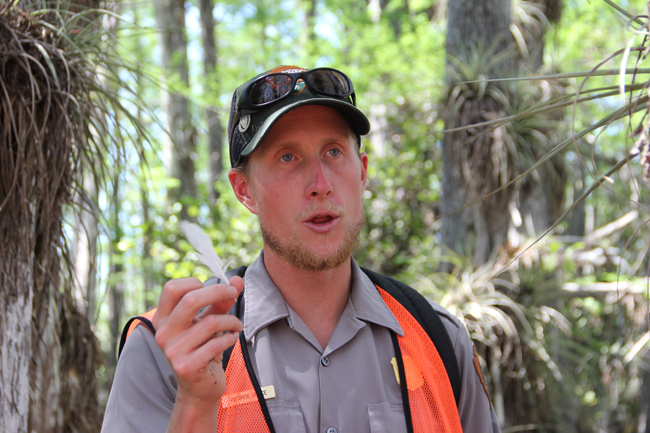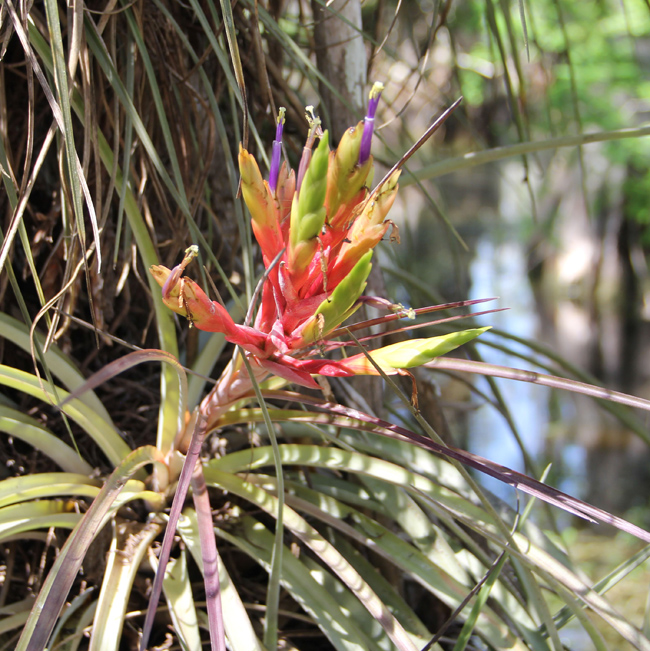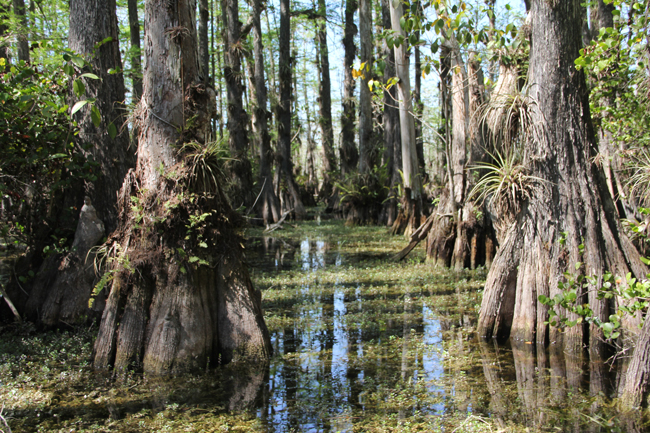Wading In Is How One Begins To Understand Big Cypress Preserve
By Daniel Candella
Patrick Boyce, a seasonal ranger at Big Cypress National Preserve, walked knee, sometimes waist-deep, into the cool swamp water of a cypress dome. “It isn’t hard to reflect back on a time before the airplanes left contrails overhead,” he said, “or to forget the van that just transported you there.”
Covering 729,000 acres, Big Cypress is almost the size of Rhode Island. It is home to a wide variety of fauna and wildlife, including the elusive and endangered Florida panther, and its fresh waters are essential to the neighboring Everglades.
However, Big Cypress “is the most imperiled ecosystem,” said Boyce.

Photo by Kaitlyn Carroll
Boyce hopes his role as a ranger can raise awareness on the preservation of this important center of life, especially for future generations to enjoy.
One way Boyce hopes to accomplish this has been to lead groups of sixth graders out of the classroom and through areas such as cypress domes, a pool dominated by tall cypress trees.
“As long as they’re outside, it’s an end in itself,” said Boyce. His message to future generations is to connect kids to the environment and not a PlayStation.
A Connecticut native, Boyce grew up in West Simsbury. He is quick with a joke, boyish in appearance, but rugged from his time spent in the wilderness. He displays a large, welcoming smile to the groups he leads on hikes through the swamps of Big Cypress.
But being a park ranger wasn’t always in his future. Boyce graduated from the University of California, Santa Cruz in 2005 with a bachelor’s degree in film and media.
From there he joined the U.S. Marine Corps in 2006 where he was a public affairs officer, including working with NATO. After the Marines he was a field guide at the Shamwari Game Reserve in South Africa, where he was certified to handle venomous snakes. He then began working in 2010 as a seasonal National Parks ranger.
Boyce said sometimes his current job is not such a glamorous life but that the benefits outweigh the negatives. “You get to live and work where people go on vacation,” he said.
A seasonal ranger is assigned to a park for a period of six months. During this time their performance is evaluated, but once you start you do have a rehire status.
He spent the past two winters at Mount Rushmore and the past two summers at Yellowstone before arriving at Big Cypress for the winter of 2013–14.
With only one month left before his reevaluation and reassignment to Yosemite, Boyce chuckled as he reflected back on his decision to come to Big Cypress. “I just really wanted to see a manatee or a gator,” he said.
Dealing with a group of sixth graders, wading knee, sometime waist-deep on warm days through murky swamps isn’t always the easiest task for a park guide.
“It’s hot, they’re tired, they usually don’t want to come back,” laughed Boyce. But he believes, “as long as you reach one kid, you’ve accomplished something.”

Photo by Kaitlyn Carroll.
Boyce educates the school children on the degradation of the swamp from high levels of pollutants like phosphorus. Boyce believes one of the biggest polluters is the sugar farmers, but said he is worried about their willingness to change because of their economical pull in Florida.
Boyce also worries about the lack of funding for the National Park Service. The 401 National Park sites around the U.S. cover nearly 84 million acres. Boyce believes the current $2.9 billion dollar budget isn’t enough and the budget is even decreasing in the 2014 fiscal year through President Obama’s $85 billion cut for the overall federal budget.
Amongst all the uncertainty of budget cuts, reevaluations, and cranky sixth-graders, it’s the nomadic life of a seasonal ranger that can tire out a lot of new rangers. Being a seasonal ranger requires their relocation every sixth month. This makes finding a date on a Saturday night pretty hard.
“Rangers date rangers,” said Boyce. Boyce said he has known married rangers who end up at different parks, “It’s hard on them, some make it, some don’t,” he said.
However, Boyce prefers a “life of solitude,” he said. He said one has to in order to sustain some sense of sanity.
Much of his paycheck goes to his obsession: books. When he’s not trekking through the swamp with school kids, he can be found in his room usually reading a novel, or “aimlessly walking in circles, yelling at walls,” he said.
Yet Boyce remains optimistic and energetic for whatever the next day should bring his way. “You have to be an optimist to be ranger, otherwise you should slit your wrist and feed yourself to the gators,” he said.
As his time at Big Cypress dwindled, Boyce said he hopes he “has made a slight impact on the importance of saving this vital ecosystem in the minds of the children he has led through the swamps.”

Photo by Kaitlyn Carroll.